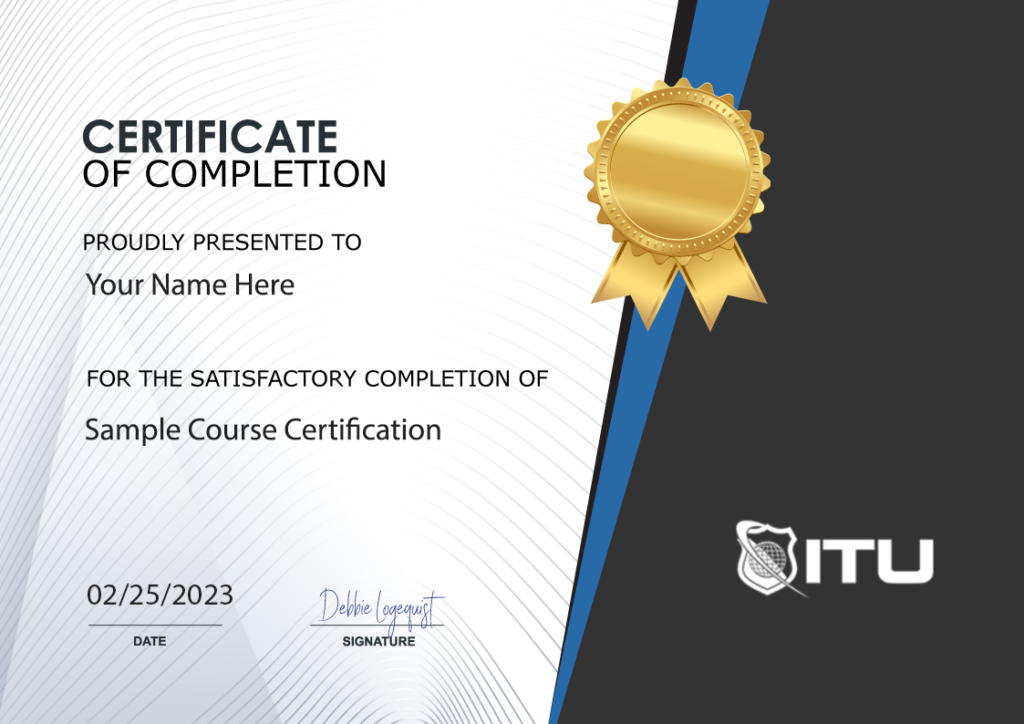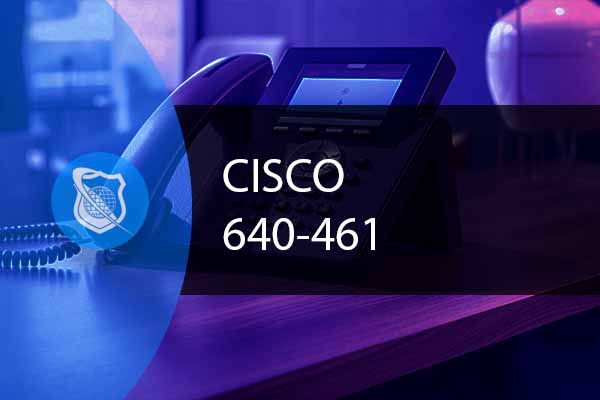Cisco Voice 640-461
This Cisco Voice 640-461 course covers the Cisco Certified Network Associate Voice (CCNA Voice) attests to the fact that the IT professional has requisite associate-level knowledge and skills needed to manage a voice network.
Included In This Course



Closed Captions



Certificate of Completion
Course Description for Cisco Voice and Unified Communications Administration
The “Cisco 640-461: Cisco Voice and Unified Communications Administration” course provides a comprehensive understanding of Cisco’s voice and unified communications systems. This course covers essential topics such as telephony, VOIP call routing, CUCME administration, and preparing networks for voice communications. Learners will gain hands-on experience with configuring and troubleshooting Cisco’s unified communications solutions, ensuring they can effectively manage and administer these systems in real-world scenarios.
Throughout the course, participants will delve into detailed modules on call routing basics, IP phone behavior, end-user interfaces, endpoint implementation, and advanced call coverage. The curriculum is designed to equip students with the knowledge needed to implement, manage, and support Cisco’s unified communications infrastructure, making them valuable assets to any IT team focused on voice communications.
What You Will Learn in Cisco Voice and Unified Communications Administration
By enrolling in this course, you will gain a robust set of skills and knowledge that will enhance your capabilities in Cisco voice and unified communications systems. Below are the key learning outcomes:
- Understanding the fundamentals of telephony and VOIP call routing
- Configuring and managing CUCME (Cisco Unified Communications Manager Express)
- Implementing and troubleshooting IP phone behavior and end-user interfaces
- Preparing network infrastructure for voice communications
- Implementing advanced call routing and coverage strategies
- Deploying and managing Unity Connection for unified messaging
Exam Objectives for Cisco Voice and Unified Communications Administration Certification
This course prepares you for the Cisco 640-461 certification exam, governed by Cisco Systems. The exam objectives include:
- Telephony and VOIP Call Routing (20%)
- CUCME Call Routing Basics (20%)
- Network Preparation for Voice (10%)
- IP Phone Behavior and Administration (15%)
- Endpoint Implementation and Call Coverage (20%)
- Implementing Unity Connection (15%)
Who This Cisco Voice and Unified Communications Course is For
This course is ideal for a variety of individuals looking to enhance their skills in Cisco’s voice and unified communications technologies:
- Network engineers and administrators
- IT professionals specializing in voice communications
- System administrators responsible for unified communications
- Individuals preparing for the Cisco 640-461 certification exam
- Beginners looking to start a career in network and voice communication
Possible Jobs You Can Get With This Knowledge
Acquiring skills from this course can open up numerous career opportunities in the field of voice and unified communications. Potential job titles include:
- Network Voice Engineer
- Unified Communications Engineer
- VOIP Network Administrator
- Systems Engineer for Unified Communications
- Telecommunications Specialist
Average Industry Salaries for People with These Skills
Professionals with expertise in Cisco voice and unified communications can expect competitive salaries. Here are some average salary ranges for relevant job titles:
- Network Voice Engineer: $80,000 – $110,000 per year
- Unified Communications Engineer: $85,000 – $120,000 per year
- VOIP Network Administrator: $70,000 – $95,000 per year
- Systems Engineer for Unified Communications: $90,000 – $125,000 per year
- Telecommunications Specialist: $75,000 – $105,000 per year
Get Started Today (Call to Action)
Don’t miss the opportunity to advance your career in voice and unified communications. Enroll in the “Cisco 640-461: Cisco Voice and Unified Communications Administration” course today and gain the skills and certification needed to excel in this growing field. Join now and take the first step towards becoming a certified expert in Cisco unified communications!
Key Term Knowledge Base: Key Terms Related to Cisco Voice and Unified Communications Administration
Understanding the key terms related to Cisco Voice and Unified Communications Administration is crucial for anyone looking to excel in this field. These terms encompass the fundamental concepts, technologies, and protocols used in Cisco’s unified communications systems. Familiarity with these terms will not only help you navigate the course material more effectively but also enhance your ability to implement, manage, and troubleshoot Cisco’s voice and communication solutions in real-world scenarios.
| Term | Definition |
|---|---|
| Telephony | The technology and science of transmitting voice over distances using electronic means, traditionally through phone systems. |
| VOIP (Voice Over Internet Protocol) | A technology that allows voice communication and multimedia sessions over Internet Protocol (IP) networks. |
| CUCME (Cisco Unified Communications Manager Express) | A solution that provides call processing for Cisco IP phones and other voice communication devices within an enterprise network. |
| Call Routing | The process of directing a call to the appropriate destination based on pre-defined rules and criteria. |
| IP Phone | A phone that uses Internet Protocol (IP) for its communication, enabling it to connect to a network and utilize VOIP technology. |
| Unified Communications | The integration of various communication tools (voice, video, messaging, etc.) into a single, cohesive system. |
| Cisco Unity Connection | A unified messaging application that provides voicemail, integrated messaging, and other communication services. |
| Endpoint | Any device (such as an IP phone, softphone, or mobile device) that is connected to a network and used to make or receive calls. |
| Call Coverage | The strategies and mechanisms used to ensure that incoming calls are answered, whether by redirecting to another phone, voicemail, or other means. |
| SIP (Session Initiation Protocol) | A signaling protocol used for initiating, maintaining, and terminating real-time sessions that include voice, video, and messaging applications. |
| H.323 | A standard protocol suite for voice, video, and data communication over IP networks. |
| Codec (Coder-Decoder) | A device or software that encodes or decodes digital data streams or signals, crucial for VOIP to convert voice signals into digital packets. |
| PSTN (Public Switched Telephone Network) | The traditional circuit-switched telephone network used for landline telephony. |
| E.164 | An international standard for numbering plans to ensure each device on the PSTN has a globally unique number. |
| Dial Plan | A set of rules that defines how calls are routed and connected within a telephony network. |
| QoS (Quality of Service) | Techniques and technologies used to manage network traffic to ensure the performance of critical applications, such as VOIP. |
| PBX (Private Branch Exchange) | A private telephone network used within an organization that switches calls between users on local lines while allowing all users to share a certain number of external phone lines. |
| SRST (Survivable Remote Site Telephony) | A feature that provides redundancy for IP telephony by allowing remote site phones to continue operating during WAN outages. |
| Trunk | A communication line or link designed to carry multiple signals simultaneously, typically used in telephony to connect switching equipment. |
| DN (Directory Number) | A number assigned to a telephone line for the purpose of call routing and identification. |
| Auto-Attendant | An automated system that answers calls and provides a menu of options for directing the caller to the appropriate department or extension. |
| Transcoding | The process of converting voice streams from one codec to another. |
| Gateway | A device that connects different network types, such as converting between IP and PSTN signals. |
| SCCP (Skinny Client Control Protocol) | A proprietary protocol used by Cisco systems for communication between IP devices and Call Managers. |
| VLAN (Virtual Local Area Network) | A logical grouping of devices in the same broadcast domain, often used to segment network traffic, including VOIP. |
| Multicast | The transmission of data to multiple recipients simultaneously, used in VOIP for efficient distribution of media streams. |
| TFTP (Trivial File Transfer Protocol) | A simple protocol used to transfer files, often used in VOIP environments for provisioning IP phones. |
| PoE (Power over Ethernet) | Technology that allows network cables to carry electrical power, simplifying the deployment of IP phones and other networked devices. |
| B-ACD (Basic Automatic Call Distribution) | A feature that distributes incoming calls to a group of agents or devices based on pre-defined criteria. |
| IVR (Interactive Voice Response) | An automated telephony system that interacts with callers and gathers information by giving them choices via a menu. |
| CUCM (Cisco Unified Communications Manager) | A call processing component of the Cisco Unified Communications System, managing call setup, routing, and devices. |
| FMC (Fixed Mobile Convergence) | The integration of fixed and mobile phone networks, providing seamless communication across different network types. |
| DID (Direct Inward Dialing) | A service that allows external callers to dial directly to an internal extension without going through an operator. |
| ANI (Automatic Number Identification) | A feature that identifies the phone number of the incoming caller. |
| DNIS (Dialed Number Identification Service) | A feature that identifies the number that the caller dialed, useful for call routing in large systems. |
| Softphone | A software application that enables voice calls over the Internet using a computer or mobile device. |
| E911 (Enhanced 911) | A system that provides the caller’s location information to emergency dispatchers when dialing 911 from a VOIP or other telephony service. |
| Jitter | Variation in packet arrival times in a network, which can affect the quality of VOIP calls. |
| MOS (Mean Opinion Score) | A measure used to evaluate the quality of voice communication, often used in VOIP testing. |
| PLAR (Private Line Automatic Ringdown) | A feature that automatically connects a call to a predefined destination when the handset is lifted. |
| BGP (Border Gateway Protocol) | A protocol used to exchange routing information between different networks on the Internet, relevant for VOIP routing. |
| RTCP (Real-time Transport Control Protocol) | A protocol used alongside RTP to monitor transmission statistics and quality of service in VOIP. |
| SIP Trunking | The use of SIP to provide voice communication services and unify voice and data networks. |
| VTC (Video Teleconferencing) | The technology that allows two or more locations to communicate by simultaneous two-way video and audio transmissions. |
| Call Admission Control | Techniques used to manage the number of concurrent calls in a VOIP network to ensure quality and prevent overloading. |
| Hunt Group | A set of phone lines grouped together to distribute incoming calls to the next available line. |
Understanding these key terms will significantly enhance your ability to work with Cisco Voice and Unified Communications systems, helping you achieve proficiency and success in this field.
Frequently Asked Questions About Cisco Voice 640-461
What is the Cisco 640-461 course about?
The Cisco 640-461 course covers Cisco Voice and Unified Communications Administration, providing comprehensive knowledge on telephony, VOIP call routing, CUCME administration, and preparing networks for voice communications.
What topics are included in the Cisco 640-461 course?
The course includes modules on Telephony, VOIP Call Routing, CUCME Call Routing Basics, Network Preparation for Voice, IP Phone Behavior, End User Interfaces, Endpoint Implementation, Call Coverage, and Implementing Unity Connection.
Who should take the Cisco 640-461 course?
This course is ideal for network engineers, IT professionals specializing in voice communications, system administrators, individuals preparing for the Cisco 640-461 certification exam, and beginners looking to start a career in network and voice communication.
What jobs can you get with skills from the Cisco 640-461 course?
With skills from this course, you can pursue roles such as Network Voice Engineer, Unified Communications Engineer, VOIP Network Administrator, Systems Engineer for Unified Communications, and Telecommunications Specialist.
What are the average salaries for jobs related to Cisco unified communications?
Average salaries range from $70,000 to $125,000 per year, depending on the specific job title and experience level.
Proudly DisplayYour Achievement
Upon completion of your training, you’ll receive a personalized certificate of completion to help validate to others your new skills.
Cisco 640-461: Cisco Voice and Unified Communications Administration Course Content
Module 1: Introduction
- Intro Part 1
- Intro Part 2
- Intro Part 3
- Intro Part 4
- Intro Part 5
- Intro Part 6
- Intro Part 7
Module 2: Telephony
- Telephony Part 1
- Telephony Part 2
- Telephony Part 3
- Telephony Part 4
Module 3: Basic Call Routing
- Basic Call Routing Part 1
- Basic Call Routing Part 2
- Basic Call Routing Part 3
Module 4: VOIP Call Routing
- VOIP Call Routing Part 1
- VOIP Call Routing Part2
- VOIP Call Routing Part 3
- VOIP Call Routing Part 4
- VOIP Call Routing Part 5
Module 5: CUCME Call Routing Basics
- CUCME Call Routing Basics Part 1
- CUCME Call Routing Basics Part 2
- CUCME Call Routing Basics Part 3
- CUCME Call Routing Basics Part 4
- CUCME Call Routing Basics Part 5
- CUCME Call Routing Basics Part 6
- CUCME Call Routing Basics Part 7
- CUCME Call Routing Basics Part 8
- CUCME Call Routing Basics Part 9
- CUCME Call Routing Basics Part 10
- CUCME Call Routing Basics Part 11
Module 6: Preparing Network For Voice
- Preparing Network For Voice Part 1
- Preparing Network For Voice Part 2
- Preparing Network For Voice Part 3
- Preparing Network For Voice Part 4
- Preparing Network For Voice Part 5
- Preparing Network For Voice Part 6
Module 7: IP Phone Behavior
- IP Phone Behavior
Module 8: CUCME Administration Basics
- CUCME Administration Basics Part 1
- CUCME Administration Basics Part 2
- CUCME Administration Basics Part 3
- CUCME Administration Basics Part 4
Module 9: CUCME StandUp
- CUCME Stand Up Part 1
- CUCME Stand Up Part 2
- CUCME Stand Up Part 3
- CUCME Stand Up Part 4
- CUCME Stand Up Part 5
Module 10: CUCME StandUp Part 2
- CUCME Stand Up2 Part 1
- CUCME Stand Up2 Part 2
Module 11: CUCME StandUp CUCME
- CUCME Stand Up CUCME Part 1
- CUCME Stand Up CUCME Part 2
- CUCME Stand Up CUCME Part 3
Module 12: End Users and End User Interfaces
- End Users And End User Interfaces Part 1
- End Users And End User Interfaces Part 2
- End Users And End User Interfaces Part 3
Module 13: Endpoint Implementation
- Endpoint Implementation Part 1
- Endpoint Implementation Part 2
- Endpoint Implementation Part 3
- Endpoint Implementation Part 4
Module 14: Call Coverage
- Call Coverage Part 1
- Call Coverage Part 2
- Call Coverage Part 3
- Call Coverage Part 4
- Call Coverage Part 5
- Call Coverage Part 6
- Call Coverage Part 7
- Call Coverage Part 8
- Call Coverage Part 9
Module 15: Calling Restrictions and Routing
- Calling Restrictions And Routing Part 1
- Calling Restrictions And Routing Part 2
- Calling Restrictions And Routing Part 3
- Calling Restrictions And Routing Part 4
- Calling Restrictions And Routing Part 5
- Calling Restrictions And Routing Part 6
Module 16: CUCME Advance Call Coverage
- CUCME Advance Call Coverage Part 1
- CUCME Advance Call Coverage Part 2
Module 17: Implementing Unity Connection
- Implementing Unity Connection Part 1
- Implementing Unity Connection Part 2
- Implementing Unity Connection Part 3
- Implementing Unity Connection Part 4
- Implementing Unity Connection Part 5
- Implementing Unity Connection Part 6
- Implementing Unity Connection Part 7
- Implementing Unity Connection Part 8
- Outro
| 5 star | 82 | 82% |
| 4 star | 17 | 17% |
| 3 star | 1 | 1% |
| 2 star | 0% | |
| 1 star | 0% |
Sorry, no reviews match your current selections
Your Training Instructor
Chris is a Sr. Cisco Instructor and leading consultant for clients throughout the U.S. Chris has over 15 years’ experience as a network engineer and 5 additional years as an instructor. Chris has worked at the service provider/partner level throughout his career, working with national and global clients to solve complex business problems through the use of technology and IT training solutions. Working with Chris, you will see a true industry expert with experience, drive, and patience unparalleled in the industry.

Subscribe To All-Access
Lock In $16.99 / Month Forever
Access this course and over 3,000 hours of focused IT training. Start your first month for only $1.00. Then lock in only $16.99 / month for life.
- Get Every Course
- Free Updates / New Content Added
- 3,000+ Hours of Training
- Price Lock Guarantee
- Games / Flashcards
- 21,000+ Practice Questions
$49.99 $16.99 Monthly
$49.00




good
Smooth delivery and easy access to LMS. Good to see that the LMS offers progress tracking. Would be great if badges were offered on completion of courses to share via Credly to future employers.